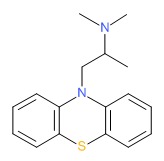NCBI Bookshelf. A service of the National Library of Medicine, National Institutes of Health.
LiverTox: Clinical and Research Information on Drug-Induced Liver Injury [Internet]. Bethesda (MD): National Institute of Diabetes and Digestive and Kidney Diseases; 2012-.

LiverTox: Clinical and Research Information on Drug-Induced Liver Injury [Internet].
Show detailsOVERVIEW
Introduction
Promethazine is first generation antihistamine that belongs to the phenothiazine class and is used predominantly as an antiemetic to treat nausea and vomiting and prevent motion sickness. Despite its phenothiazine structure, promethazine has not been linked to instances of clinically apparent acute liver injury.
Background
Promethazine (proe meth' a zeen) is a first generation antihistamine that is used widely to treat and prevent nausea and to a lesser extent to treat allergy symptoms and as a mild sedative. Promethazine belongs to the phenothiazine class of antihistamines and is a potent antiemetic. Because of its sedating effects, promethazine is also used for anxiety, tension and as a mild sleeping aid. Promethazine was approved for use in the United States in 1957 and continues to be widely used with more than 10 million prescriptions filled yearly. Promethazine is available in multiple forms including tablets, capsules, syrups, suppositories and liquid solution for injection generically and under the brand name Phenergan. Unlike other antihistamines, promethazine is not available over-the-counter. Current indications include nausea, preoperative sedation, nighttime sedation, rhinitis and allergic symptoms, cough and respiratory symptoms, and treatment and prevention of motion sickness. The typical recommended dose in adults is 12.5 to 25 mg orally or by rectal suppository, which can be repeated every 4 to 6 hours as necessary. Common side effects include excessive sedation, impairment of motor function, confusion, dizziness, extrapyramidal symptoms, blurred vision, dry mouth and throat, palpitations, tachycardia, abdominal distress, constipation and headache. Antihistamines can worsen urinary retention and glaucoma.
Hepatotoxicity
Despite widespread use and similarity to phenothiazines, promethazine has not been clearly linked to liver test abnormalities or to clinically apparent liver injury. The reason for its safety may relate to low daily dose and limited duration of use.
Likelihood score: E (unlikely to be a cause of clinically apparent liver injury).
References on the safety and potential hepatotoxicity of antihistamines are given together after the Overview section on Antihistamines.
Drug Class: Antihistamines
PRODUCT INFORMATION
REPRESENTATIVE TRADE NAMES
Promethazine – Generic, Phenergan®
DRUG CLASS
Antihistamines
Product labeling at DailyMed, National Library of Medicine, NIH
CHEMICAL FORMULA AND STRUCTURE
| DRUG | CAS REGISTRY NUMBER | MOLECULAR FORMULA | STRUCTURE |
|---|---|---|---|
| Promethazine | 60-87-7 | C17-H20-N2-S |
 |
- Promethazine.[StatPearls. 2024]Promethazine.Southard BT, Al Khalili Y. StatPearls. 2024 Jan
- PROMETHAZINE-INDUCED THROMBOPHLEBITIS IN A NIGERIAN MAN: A CASE REPORT.[West Afr J Med. 2023]PROMETHAZINE-INDUCED THROMBOPHLEBITIS IN A NIGERIAN MAN: A CASE REPORT.Dike CM, Okere PCN. West Afr J Med. 2023 Dec 4; 40(12 Suppl 1):S38.
- NTP Toxicology and Carcinogenesis Studies of Promethazine Hydrochloride (CAS No. 58-33-3) in F344/N Rats and B6C3F1 Mice (Gavage Studies).[Natl Toxicol Program Tech Rep ...]NTP Toxicology and Carcinogenesis Studies of Promethazine Hydrochloride (CAS No. 58-33-3) in F344/N Rats and B6C3F1 Mice (Gavage Studies).National Toxicology Program. Natl Toxicol Program Tech Rep Ser. 1993 Dec; 425:1-272.
- Review Dimenhydrinate.[LiverTox: Clinical and Researc...]Review Dimenhydrinate.. LiverTox: Clinical and Research Information on Drug-Induced Liver Injury. 2012
- Review Meclizine.[LiverTox: Clinical and Researc...]Review Meclizine.. LiverTox: Clinical and Research Information on Drug-Induced Liver Injury. 2012
- Promethazine - LiverToxPromethazine - LiverTox
Your browsing activity is empty.
Activity recording is turned off.
See more...